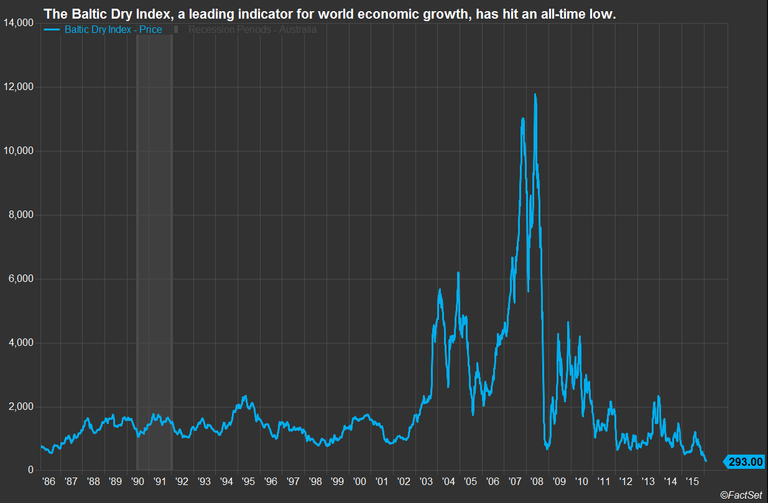This week we tweeted that the Baltic Dry Index, traditionally a leading indicator of world economic growth, hit an all-time low, dipping under 290 points. The index has been falling steadily since August 2015, when it peaked at just over 1200. The sharp drop is the result of several factors, including increased ship construction in China and falling prices of commodities like iron ore.

The BDI has historically been linked to overall global economic health because it tracks the price of shipping raw materials like coal, iron, or grain via cargo ship and is therefore closely association with the global demand for raw materials. Analysts believe that higher demand for raw goods directly correlates with higher demand for shipping capacity, driving up shipping costs as a result.
But while the index has continued to freefall, some are questioning whether the index is still a reliable indicator of economic growth. Because the index tracks the price of shipping, not volume, it may not be an accurate reflection of how much shipping is actually taking place. As one astute LinkedIn commenter pointed out, the global shipping industry has continued to build bigger and bigger ships for the last few years while the price of oil to power those ships has dropped. And while the ships themselves have grown, the global marketplace to generate proportionate increases in volumes of goods requiring shipping has not.
It’s true that the BDI has fallen by 75% in six months and is now lower than ever before, but perhaps that is not deserving of panic.
We saw the BDI fall sharply during the global economic recession in 2008, but current conditions don’t reflect the same dire outlook. The BDI is simply a price index that reflects the balance of supply and demand, and right now supply is far ahead of demand. Stronger global economic growth, a surge in trade in response to lower shipping rates and rising commodity prices will all potentially be factors in boosting demand. On the supply side, low transport prices may force many shippers to scrap their older vessels, which will help to alleviate some of the glut. It may take some time for supply and demand factors to get back in sync, but the current low levels of the BDI do not signal that the sky is falling.
